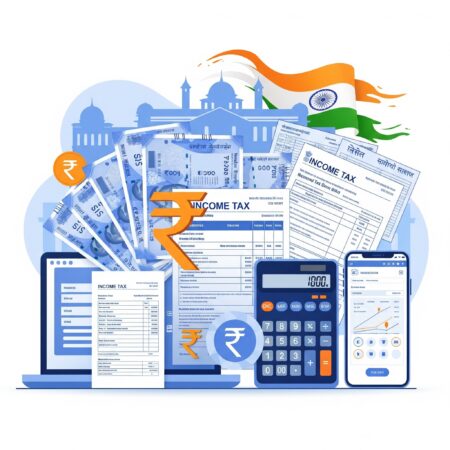Introduction to the Indian Tax System
The Indian tax system forms the backbone of the nation’s finances—powering everything from public infrastructure and education to welfare and development. For both individuals and businesses, navigating this system means keeping pace with a complex, evolving framework of rules. Recent reforms include the new income tax regime, ongoing GST updates, and a significant shift toward digital tax compliance. Understanding these elements is more crucial than ever. This guide unpacks the tax system’s structure, the latest updates, real-world impacts, and key reforms for FY 2024–25 (AY 2025–26).
Table of Contents
- The Structure of the Indian Tax System
- Impact on Individuals
- Impact on Businesses
- Economic Implications
- Government Initiatives and Reforms
- Conclusion
- Call to Action
1. The Structure of the Indian Tax System
India’s tax system is broadly split into two:
- Direct Taxes: Levied on income and profits (paid directly by individuals or companies).
- Indirect Taxes: Applied to goods and services, ultimately paid by consumers.
1.1 Direct Taxes
Income Tax (Individuals & HUFs)
Since 2020, taxpayers can select between two regimes:
A. New Regime (Default, as of FY 2024–25):
| Annual Income (₹) | Tax Rate |
|---|---|
| Up to 3,00,000 | 0% |
| 3,00,001 – 6,00,000 | 5% |
| 6,00,001 – 9,00,000 | 10% |
| 9,00,001 – 12,00,000 | 15% |
| 12,00,001 – 15,00,000 | 20% |
| Above 15,00,000 | 30% |
Section 87A rebate: No tax if gross income is up to ₹7,00,000 (after rebate).
B. Old Regime (with deductions, if opted):
| Annual Income (₹) | Tax Rate |
|---|---|
| Up to 2,50,000 | 0% |
| 2,50,001 – 5,00,000 | 5% |
| 5,00,001 – 10,00,000 | 20% |
| Above 10,00,000 | 30% |
Section 87A rebate: No tax up to ₹5,00,000 (after rebate).
Example for FY 2024–25:
Salary: ₹10,00,000
- Under new regime: Total tax before cess = ₹1,00,000
- Under old regime: Total tax before cess = ₹1,12,500 (minus deductions)
Corporate Tax Rates
- Standard for Indian companies: 22% (plus surcharge and cess)
- New manufacturers (registered post Oct 2019): 15%
- Companies with turnover ≤₹400 crore (non-concessional): 25%
- Foreign companies: 35% (plus surcharge and cess)
Wealth Tax has been abolished since 2015. Only surcharges/cesses remain for high incomes.
1.2 Indirect Taxes
Goods and Services Tax (GST)
- Rates: 0%, 5%, 12%, 18%, 28% (+cess on luxury/sin goods)
- July 2024 Update: Minor adjustments (e.g., solar cookers, select dairy, rail services); core slabs unchanged.
GST Examples:
| Item | GST Rate | Example Price | With GST |
|---|---|---|---|
| Essentials (milk, veggies) | 0% | ₹100 | ₹100 |
| Groceries, medicine | 5% | ₹1,000 | ₹1,050 |
| Processed foods, garments | 12% | ₹5,000 | ₹5,600 |
| Electronics, restaurants | 18% | ₹2,000 | ₹2,360 |
| Luxury cars, tobacco | 28%+cess | ₹10,000 | ₹12,800+ |
Customs Duty
- Levied on imports and exports.
- Trend: Higher duties on select electronics/luxuries, boosting Make in India.
Excise Duty
- Subsumed under GST except for alcohol, petroleum, etc.
2. Impact on Individuals
- Progressive Taxation: Higher incomes pay proportionally more.
- Regime choice: New (fewer deductions, higher rebate) vs. Old (detailed deductions).
- GST impact: Adds to household expenses.
- Compliance: Predominantly online e-filing.
Example:
A software engineer earning ₹8 lakh:
- New regime likely easier, with lower tax if no major deductions.
- Old regime advantageous only if substantial investments (80C, 80D, etc.).
3. Impact on Businesses
- Lower corporate tax (22%) and 15% for new manufacturing eases MSME burdens.
- Regular, digitized GST compliance is mandatory (monthly/quarterly returns, e-invoicing, e-way bills).
- Frequent policy and rate changes require constant adaptation.
Example:
A small retailer must issue GST invoices, file returns monthly, and keep up with every GST Council notification.
4. Economic Implications
- Disposable Income: Indirect taxes reduce money available for savings/investment.
- Investor Climate: Lower direct taxes attract investments; complex compliance deters some business.
- Inequality: Indirect taxes can disproportionately impact low-income households.
5. Government Initiatives and Reforms
- Tax Reforms: Introduction of the new regime, regular GST tweaks.
- Digitalization: E-filing, pre-filled returns, instant PAN, digital KYC, faceless assessments.
- Business Incentives: Lower tax for new manufacturing, “Startup India” tax holidays (3 of 10 eligible years).
Frequent GST rate updates mean businesses should monitor council notifications and compliance apps.
6. Conclusion
India’s tax system is dynamic—continuing to balance public revenue needs with the push for growth and social justice. Significant reforms like GST and the simplified income tax regime have made the system more accessible, yet the onus is on taxpayers to stay informed, embrace digital compliance, and make well-informed choices.
Empower your financial wellbeing—stay up to date with tax reforms, optimize your regime selection, and leverage digital tools for smoother compliance. Your informed participation fuels India’s growth!

Author of the Article above


